The Year of the Pig: Adventures in Cookbooks, River Cottage, and Chinatown
I’ve bought two cookbooks in the last week that teach you how to do funny things with pigs. The first, which I haven’t had nearly enough time to explore, is Michael Ruhlman ’s Charcuterie , co-written with Brian Polcyn, a book about the wonders of salting, smoking, and curing meat, a tradition of which pork is the oinking mascot. Much has been written of this book’s breakthroughs in bringing a craft of great tradition, skill, and history, into the home kitchen. While my Brooklyn Italian landlord will likely become a Protestant before she lets me hang curing bacon from my fire escape, I’m nevertheless very excited to continue my adventures like duck confit , the wondrous reappropriation of old world techniques into a New York apartment.
The other new member of my bookshelf is perhaps one of the most inspiring cookbooks I have ever encountered. Pork and Sons is in every respect a soulful salute to the animal we call pig, written by Stephane Reynaud, the owner and chef of a restaurant called Ville 9 Trois just outside of Paris, whose grandfather presided over the village square as butcher ("or rather, professor of butchery") for 40 years. The man was seven when he saw his first pig slaughter. It is by turns entrancing, whimsical, thorough, charming, inviting, and, above all, knowledgeable. The pig is known for its versatility, and the authors know that well--from head to toe, snout to tail, the pig is braised, simmered, salted, cured, roasted, boiled, confited, grilled, baked into tarts, stuffed into sausages, and shredded into pate. There is a section on Wild Boar, how to make Blood Sausage (just what it sounds like), and photographs of all types of cured hams, from serrano from Spain to speck from Austria and everything in between. It is inspiring to flip through and imagine the possibilities, while you learn something on every page. Unlike most cookbooks, it functions as a narrative. You literally start reading on page one, and the life of a pig and the community of jocular French characters who cherish it emerge, through photographs, drawings, and stories, as if in a good European arthouse film--wryly charming, slightly self-effacing, full of magic. Oh I can’t say enough good things about this book. It’s also beautiful, published by Phaidon , who are famous for their art books.
Inspired to go out on a limb, I went to a butcher last weekend and brought home a pork belly (well, half of one). It was really heavy.
At first, I planned on making some bacon from Charcuterie ,
but was dissuaded after reading about pink salt, nitrates/nitrites, and
botulism poisoning. While true bacon doesn’t need these things (just
sugar and regular salt), the authors highly recommend the nitrates for
beginners to keep the meat from going rancid and poisoning yourself. I
decided to try bacon another day.
However, I already had a pork belly waiting in the fridge. So I made a Chinese soup from the River Cottage master himself, Hugh Fearnley-Whittingstall. Don't know who this man is? Neither did I. Read this , from Grocery Guy, of Edible Brooklyn fame :
“He [Hugh] is illustrating, in a very conversational, easy to read, common folk sort of way, where your food did and should come from. No preachy liberal guilt, more like a joyous, Francis of Assisi kind of thing except with food, not the Lord. [...] Say you want to raise sheep. This book will tell you how. Want to really take ownership of your own food and butcher those Spring lambs? He'll show you. Rake clams and then saute them on the beach? Slop pigs and then make bacon or Ham? Feed yourself with a victory garden? Go crabbing? Shoot a brace of nice coneys and braise them? Plant fruit trees and then make sorbet
out of the fruit? This book will make you at least feel like you could do it.”
My next step might be to buy this book , which will never accidentally be purchased by a vegetarian:
I just love the way they throw a huge piece of raw flesh on the cover and let it speak for itself. It's not some nicely seared piece of sirloin surrounded by truffled cream spinach, or a picture of a living cow in a pastoral setting. This is upfront, and if you can't face it you probably shouldn't be eating meat. I digress. This Chinese soup recipe couldn’t be much easier. I had to go to Chinatown to buy rice wine, a clear, mild sort of liquor that cost 6 bucks. I also picked up rice wine vinegar and some refrigerated Chinese noodles (I recommend a store called Dynasty Supermarket on Elizabeth St., and there’s a Chinese liquor store a few doors down for the rice wine. On the way to the F train at E Broadway, on Canal St., there’s a place that sells $1 sheets of homemade pork, beef, and chicken jerky, and it’s really, really good - read about it and a good story here .)
Hugh Fearnley-Whittingstall's Aromatic Pork Belly Hot Pot
- 3 pound pork belly, with rind still on
- About 2 cups pork or chicken stock (if available, otherwise water)
-
One bunch spring onions, divided in two piles
- 1/4 cup soy sauce
- 5 tablespoons Chinese rice wine ( about )
- 2 tablespoons rice wine vinegar ( about )
- 2 tablespoons demerera (or light brown) sugar
- 3 star anise (or a tablespoon star anise powder)
- 4 inch piece of fresh ginger root, peeled and sliced in rounds
- a good pinch of dried chilli flakes or Chinese chili-garlic sauce, to taste
Note: if the idea of a pork belly scares you or seems too fatty, the other broth ingredients would make a delicious combination with any other low-cost cut of meat that needs acidity and long cooking time to
become flavorful.
Above is the belly once I cut the top of it off, which had ribs running through it. If possible, ask for a belly with no ribs. Cut it into 2-inch long rectangles, think bite-size. I was able to work around the rib bones and get a good amount of meat from there, too. Put the pieces in a large pot, cover with boiling water and simmer for five minutes, skimming off the foam and such that rises to the top. Pour it into a colander, as if draining pasta, and rinse the pot clean. Return the belly to the pot and cover again, this time with beef stock or broth. Add the remaining ingredients except half the spring onions, lower to a simmer, and cook for 2 hours or so, until the belly is tender and succulent.
Next, remove the belly pieces with a slotted spoon and, if possible, strain the sauce through a cheesecloth or strainer. Return to the pot and crank up the heat, reducing the sauce until lots of moisture boils off and the flavors become deep and rich. In the meantime, cook some plain noodles, preferably Chinese (you can find them dried or in the refrigerated and frozen sections of Asian grocers). When ready to serve, return the pork to the pot, and warm through. Put the noodles into a large bowl, cover with the soup, and scatter more green onions cut on a diagonal. Serve immediately.
Asian, Charcuterie, Chicken Stock, Hugh Fearnley-Whittingstall, Michael Ruhlman, Pork, Pork, Pork Belly, River Cottage

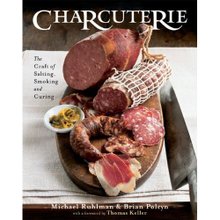
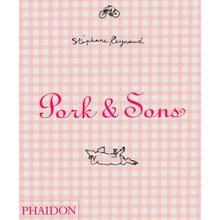
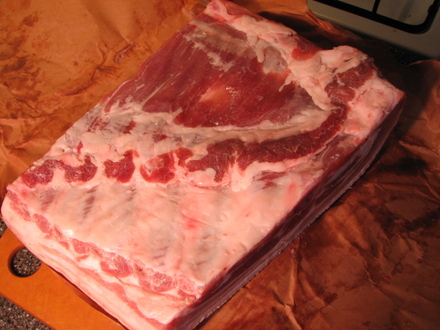

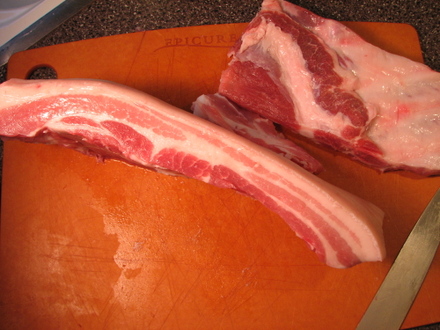
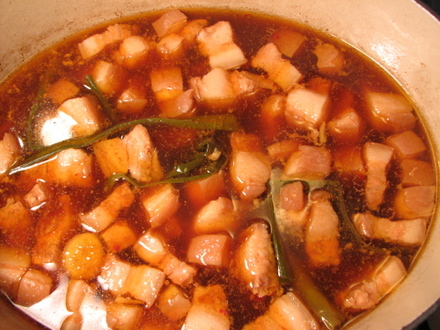
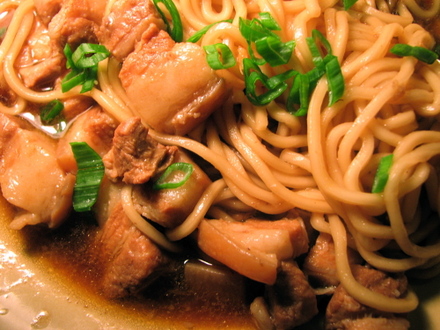
Comments:
Blog Comments powered by Disqus.